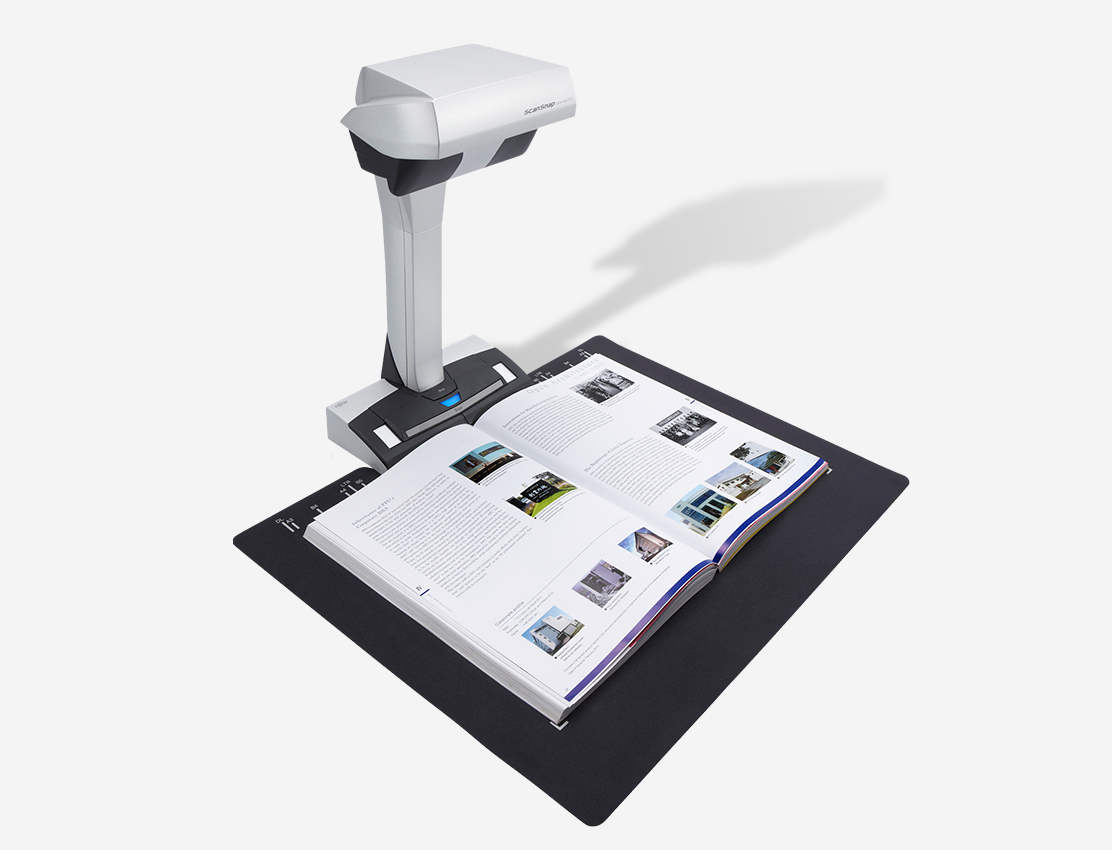Curating digital versions of your art so you can further your craft.
The impulse to create is one of the things that makes us human, and a good art scanner can help us make the most of our creations.
Maybe you are digitizing your portfolio for your first client pitch, posting your work to sell online, or simply sharing it with a close friend who wants a copy on their phone. Perhaps the most important digital application for you is one you haven't even considered yet. Regardless, if you want to digitize your creative efforts efficiently, it's worth investing in a scanner for artwork.
It's important to find a tool that will capture the essence of your art, accurately digitizing aspects like shape and color. Today's scanners combine quality and speed with an intuitive user experience. That translates into more time creating, less time curating.
When considering the best scanners for artwork, it's important to evaluate a few key criteria. How much space do you have? Do you need to connect your scanner to your computer or phone, or network it with multiple devices? Do you plan to reprint copies? How large are the pieces you plan to scan? For how the answers to these and other questions may impact your buying decision, continue reading.
Need help picking the right scanner for your needs? Check out our guide, How to Choose the Right Scanner for Your Computer.
Jump to a section:
What is an art scanner?
Art scanners allow creators to digitize their work without damaging it, with some modern models offering totally contactless scanning. And most importantly, you don’t have to be a technology wiz to operate them with confidence.
Ideally, an art scanner will provide high-resolution digitization capabilities, capturing fine details like brush strokes and canvas textures in the scanned image. Many art scanners also include bundled software, offering image touchup and auto-skew correction features that work to make your digital scans look great without much fuss. With the right pick, you’ll be able to create accurate, high-quality digital representations of your artwork, allowing you to present your personal creations or collected pieces on social media, websites, and auction houses with ease.

Why should you invest in an art scanner?
Are you interested in capturing high-quality files with a minimum of effort? Do you want the ability to enhance or creatively modify your originals? Hoping to share your digital files between devices? Then an art scanner might be just the thing for you. Current models can capture high-resolution digital images, enhance and manipulate them for photo illustration projects, and easily connect to your devices via an industry-standard USB connection.
If your work tends to be fairly large, you could use an 11 x 17 scanner for artwork, which would allow you to scan subsections of your original and then use software to assemble those sections into a complete digital copy. For example, if you’re looking for the best scanner for comic book artists, you might want this functionality.
Did You Know? GeekDad reviewed the SV600 and concluded, 'I have just found Scanner-Geek Nirvana … this thing is pure and simple magic.'
Key features in an art scanner
Most artists tend to be very particular about how they organize their creative and working spaces. The best scanner for art work will meet your digitization needs with a minimal footprint. One option that does just that is the ScanSnap SV600, which weighs in at just under seven pounds and measures a sleek 8.27'×6.14'×15.08'. Perfect for that spot at the edge of your work desk.
Another feature you should research is whether the scanner functions via a document feeder, flatbed, or contactless scanning.
- Automatic document feeders offer rapid scanning speeds but often rely on a series of wheels and rollers to process stacks of paper quickly. Depending on how they are implemented, these feeders can bend, crease, or leave grooves on the artwork as it moves through the scanner.
- Flatbed scanners are much slower than automatic document feeders since each page needs to be manually placed onto a glass bed and enclosed with the lid before it is scanned. However, this process is much safer for artwork since no moving parts interact with the page during the scanning process. It is not fully contactless, though, so it may not be the best fit for scanning more fragile art pieces.
- Contactless scanners rely on a mechanism above the scanning area to digitize the piece under it. With these scanners, nothing comes in contact with the document except the loading area underneath it, making them an excellent option for scanning old or fragile art pieces.
Other extras that could come in handy include duplex scanning, which captures both sides of two-sided documents in one scan, and long document capability for those tricky large originals.
Color accuracy, depth, and resolution: How an art scanner preserves your work
When choosing an art scanner, how it processes your digital image is just as important as how it handles the physical print. To ensure that scans look as sharp and representative of the original print as possible, consider scanners that prioritize the following features:
- Color accuracy represents how well your digital image represents the real-world color values of the original art print. Art scanners should be properly equipped and calibrated to meet 100% of the sRGB (standard Red Green Blue) color space to ensure the most accurate scans.
- Color depth, also known as bit depth, represents the number of bits (i.e., the amount of data) required to store color information for each pixel in an image. The more bits in the image, the more colors that are available to use — for example, an 8-bit image can only use 256 colors, while a 24-bit image has over 16 million colors available. Of course, this also means that larger color depth rates require more storage space.
- Resolution determines how sharp and detailed your scanned images appear. The dots per inch (dpi) rating of a scanner determines the resolution available to it — the higher the rating, the more detailed your scans will look (which also means larger file sizes). A good rule of thumb is to capture digital scans with a large dpi value and scale down if needed rather than the other way around. Doing so will give you the most flexibility, whether you’re posting smaller images on Facebook or creating physical, full-size reprints of the original work.
Finding the best art scanner for your medium
Each artistic medium’s properties will influence their artists’ approach to buying a scanner — charcoal sketches need a different approach than oil paints on a canvas. Keep the following considerations in mind while shopping for an art scanner that can bring out the best in your work.
- Paintings, whether watercolor, oil, or acrylic, have a unique texture that helps to form the work’s character. Even the choice of paper or canvas, with its minuscule grooves and valleys, makes a painting truly unique. Your scanner should be able to replicate those characteristics. High resolutions and scanners with deeper scanning beds or other ways to move the light source further from the material will help to bring out those natural elements in your digital images.
- For drawings, you want to ensure that your piece doesn’t lose any detail, no matter how big or small. Higher dpi rates will give you more room to work with when archiving or sharing your digital files. Also, consider scanners capable of scanning a variety of paper sizes for maximum flexibility.
- Recently developed photos will likely benefit the most from the speed of an automatic document feeder as long as it offers a straight path through the scanner to avoid causing damage. Older photos, however, will likely need a flatbed or overhead scanner to avoid further damage.
Create. Curate. Create again.
The act of creation can feel sacred, but nothing ruins that feeling faster than wasting hours trying to digitize your portfolio. Compiling your work in digital form should complement your creative efforts. With that in mind, look for a scanner with software that offers an intuitive user experience and the power to organize your files clearly and easily.
The driver and image capture software should also be able to handle the quality and quantity you need, while things like paper separation, image enhancement, and file navigation will reduce the hassle involved with digitizing your creative work.
Did You Know? The RICOH fi-7700 document scanner has a large 11' x 17' flatbed that can scan fast with cover open and has 1200dpi interpolated resolution for great image reproduction. Click here to learn more.
These days, the best scanner software allows even the most rigid analog art loyalists to play and create in the digital space. Image manipulation techniques become fertile fields for creative exploration. Explore for fun, or perhaps even develop a digital revenue stream with your work. Scan, upload, and organize. Then get back to what you do best — creating.
Our recommendation: RICOH ScanSnap SV600
This versatile scanner can meet all of your needs, without taking up all of your space. Its sleek size and appearance are complemented by powerful image capture software. The ScanSnap SV600 is contactless, so you can scan sensitive and thick artwork up to 1.8' without having to risk damaging it. ScanSnap Home makes managing scanned documents a breeze, combining several key organization and editing features into one hub. Plus, the ScanSnap SV600’s ability to scan up to 10 documents at once and save them separately minimizes the amount of time you’ll spend scanning your work in the first place.
Another standout feature of the ScanSnap SV600 is its ability to minimize distortions from scanned artwork as well as books and magazines. Auto Book Correction will flatten and correct any curve distortion that you might experience from artwork included in a format like a zine, while its Point Retouch functions can remove fingers from scans if you need to hold artwork in place.
The ScanSnap SV600 boasts an optical resolution of up to 285 dpi for horizontal images and up to 283 dpi for vertical images, and can scan large documents that ADF scanners can’t. If you’re looking for a versatile scanner that can digitize your artwork without any risk of damage, the ScanSnap SV600 is an excellent choice.
Compact, capable and versatile. Consider the ScanSnap SV600 for your artwork digitization.
Note: Information and external links are provided for your convenience and for educational purposes only, and should not be construed, or relied upon, as legal or financial advice. PFU America, Inc. makes no representations about the contents, features, or specifications on such third-party sites, software, and/or offerings (collectively “Third-Party Offerings”) and shall not be responsible for any loss or damage that may arise from your use of such Third-Party Offerings. Please consult with a licensed professional regarding your specific situation as regulations may be subject to change.










